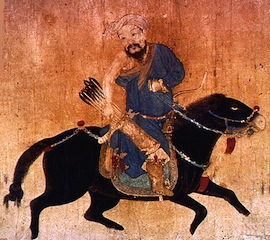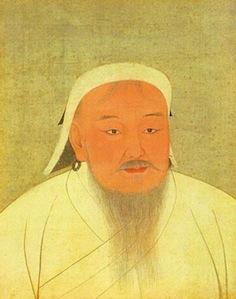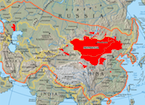The first Westtown School World History Film Festival has come and gone. Two weeks before Thanksgiving my students were channeling Ken Burns — and serving as witting accomplices in my continuing shift toward student ownership of learning.
Some background: Three years ago my World History class read sections of Jack Weatherford’s Genghis Khan and the Making of the Modern World, supplemented with excerpts from David Morgan’s The Mongols. I lectured on Mongol battle tactics and we had great discussions on all aspects of the Mongols. The students wrote argumentative essays making a case for how best to understand the place of the Mongols in history.
Last year, we read very brief selections from Weatherford, Morgan and Gregory Guzman’s Were the Barbarians a Negative or Positive Factor in Ancient and Medieval History. I then asked my students to choose what aspects of the 12th and 13th century Mongol experience they wanted to study and how they wanted to share what they had learned with their peers. Two weeks later, they had all learned a great deal. Collectively, the class had covered more ground in more depth in their own research than they would have if we had read all of Weatherford or all of Morgan. Among the projects that emerged: A wiki on religion and women, two Prezi on different military conquests, a film demonstration of cooking Mongol foods, and a poster board presentation on the ways that the environment shaped Mongol culture.
This year I decided to continue the individualized learning approach, but I chose the communication medium beforehand: documentary film. Greedily, I wanted a broader audience for my students’ work, and I wanted an excuse to learn to make this sort of film.
On location
I partnered with one of our librarians who has experience in film and we adapted last year’s assignment. In choosing a medium my students weren’t practiced in, learning the communication tool became a bigger part of the project than the content — I hadn’t anticipated this! In some cases students spent more time worrying about finding 20 to 30 images for their three-minute films than they did exploring and reading the wealth of book and online materials at their disposal. The actual editing — the alignment of audio with visual imagery and the final rendering — all took longer than any of us had anticipated.
An additional reason for the students’ fixation on finding images was our topic’s setting in the 13th century. No one from Genghis Khan’s family ever sat for a portrait. Most of the paintings of the Mongols were done by the victims of their conquests. Modern day depictions of the Mongols — from movies and video games — tend to emphasize their military blood thirstiness. Fortunately, there’s a wealth of photographs of modern day Mongol material culture — everything you might expect from ponies, to yaks, to gers (yurts), to sheep, to clothing. Equally abundant are photographs of the expansive and forbidding Asian Steppes. Extensive maps provide multiple opportunities for students to show expansion, contraction and trade routes. Easily adapted and added to, the maps were the most facile modern image to adapt to the past.
More challenging were their efforts to picture the khurultai (the council of chiefs) or the burning bush military tactic, or the orderly looting of a city to insure maximum take and minimum waste. How do you depict the use of propaganda to terrorize a city into surrender without bloodshed? How do you recreate Genghis Khan’s establishment of the legal code granting rights to women, religious toleration for all, and a near equality of treatment of everyone before the law?
Visual literacy and creativity within the limits imposed by the sources frustrated and inspired my students (and increased our respect for Ken Burns). We had hoped that we could find most of our images on websites such as Flickr or morgueFile. These two sites provide wonderful images on a wealth of topics, but the 13th century Mongols are not among them. In the end, students did find sufficient images, but we could no longer be sure of our rights to include them in our work. We decided the films would not be published outside of Westtown. I learned an invaluable lesson on the relation of film topic selection to available materials! Students practiced correct image citation using our school’s Noodletools program and generated both image and text source lists as a part of the project.
Student evaluation & assessment
The final part of the assignment asked students to write self evaluations. Some groaned but others perked up at this chance to unpack for me their process and understanding of their films. Two students wished I had allowed them to enlist their friends to re-enact scenes from the Mongol conquests or events in Genghis Khan’s life. Last year I had allowed this and been somewhat disappointed by the silliness of what was shown. I think next year I will return to allowing live action with certain restrictions. I could also see students using toy soldiers and photographing these to show different parts of the narrative developed in their films.
Several students explored how much they had learned. Given that most of them knew nothing more about the Mongols than to confuse them with the invaders in the Disney movie Mulan (the story of Mulan takes place during the Han Dynasty 206 BCE-200 CE), they all felt they had learned a great deal. One student did admit to feeling that ” I don’t think that I learned a whole lot about their society and culture. I learned a lot about their battle tactics though.” I asked him if watching his peers’ films had helped to round out his understanding, and he did agree that it did. He had moved so quickly from project introduction to image creation (he drew battle formations), he never bothered to ask himself why the Mongols were so adept at executing their formations.
All of my students had the chance to synthesize the class’s collective learning during our final exam. I was pleased with all of my student’s exams. I would rather have not ended the term with an exam essay, but traditional exams in the fall term are an expectation in our school. What I hope is that my exam allowed students to reflect upon and incorporate their research and the research of their classmates. What I assessed was student synthesis and application of learning in areas we had not specifically discussed at any point in our look at the Mongols.
Students had two essay choices:
1. How did the Mongols of the 11th to 13th centuries live within the limits imposed upon them by their environment? What choices did they make to maximize their ability to thrive? Be sure to have a strong thesis arguing for your understanding of the inter-relationship of environment to civilization/culture.
2. Genghis Khan took a people that probably numbered 100,000 fighting age men and conquered Eurasia. His borders ranged from present day Beijing, China to Baghdad, Iraq and Moscow, Russia in the West. How did he create an alignment of strengths such that the apparent weaknesses of his people were irrelevant to his conquests? In your answer be sure to be very specific about the weaknesses and the strengths. You must have a thesis you are arguing.
Looking ahead
What about next year? If I continue to teach the Mongols, I will make three adjustments: I will build in expectations for a greater baseline understanding of the Pax Mongolia for all students regardless of their specific area of interest and growing expertise. I might not insist on a film, though I think I will require a film from every student over the course of the year — perhaps I will let them choose which project/topic to render in film. And my librarian and I will work to build an image file for our students for this image-challenged time period. Ideally, research, script righting, and film construction and editing would consume equal amounts of student time with image searching taking less time.
Margaret Haviland also wrote about her shift toward more project-based, individualized learning in a Voices post about her World War I unit, “Constructing History in Our High School Project-Based Classroom.”
Images: Wikipedia Commons
Margaret Haviland
Latest posts by Margaret Haviland (see all)
- Student Creativity: the Importance of License and Limits - April 24, 2013
- Our US History Student Film Festival - January 31, 2013
- How I Spent My Summer Vacation — Teaching US History in Six Weeks to 10 Students Around the World - October 2, 2012





Dear Margaret,
I LOVED reading about how you’ve challenged your students and thank you for writing about it. You talked about the challenge of balancing student time within the content and learning the media. Boy does that resonant with me!!!
Don’t you think that this is a hurdle that many people face?
If it is, I wonder how we can think about learning digital tools in a different way or is it more of expanding the way we think so “teaching the curriculum” really includes the time it will take to use 21st century digital tools. Sometimes I wonder if the “people” who want us to use these realize that it will take a significant amount of time to teach the foundation upon which students can then do these higher level kinds of project.
I am hopeful, after listening to a fair amount of Common Core hype, that CCS will leverage communal learning of these tools…much as we now teach 6-Trait writing from within the English classes for example. But there’s no doubt that teaching in this way is NOT time efficient if blasting through the timeline is a main objective.
Thanks again for surfacing this terrific example and putting some limelight on this issue that will have to become part of the conversation.
marsha
BTW….have you seen Genghis series written by Conn Iggulden? I think they’re somewhat historically accurate (definitely fiction first though) but a blast to read. http://www.amazon.com/Genghis-Birth-Empire-Conn-Iggulden/dp/038534421X/ref=sr_1_4?s=books&ie=UTF8&qid=1325194603&sr=1-4 The newest in the series just came out and, since the original series finish with the death of Genghis….we now learn about the start of Kublai reign. I will freely admit that this series caused me to really admire what Genghis was able to accomplish and stunned at his brutality.
Dear Margaret,
I wanted to include a new 2.0 application that I thought was useful for collecting pictures, but couldn’t find it when I posted last time.
Pinterest http://pinterest.com/ seems like it might be a great way to help your students collect all their pictures and have them in collections. I wonder how to maximize the “social-ness” of this into a collaborative sharing….
marsha